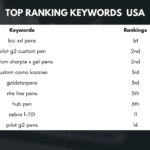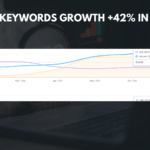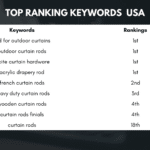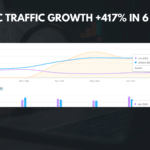
|
Getting your Trinity Audio player ready... |
E-commerce advertising refers to the practice of promoting products or services through various digital channels to drive traffic, generate leads, and increase sales for online businesses. In today’s digital age, where consumers are increasingly turning to the internet for their shopping needs, e-commerce advertising has become a crucial component of any successful online business strategy.
This blog post will provide a comprehensive guide to e-commerce advertising, covering topics such as understanding your target audience, choosing the right advertising platform, crafting an effective advertising strategy, creating compelling ad content, utilizing social media advertising, leveraging email marketing campaigns, maximizing search engine advertising, measuring and analyzing advertising results, and continuous optimization for long-term success.
Key Takeaways
- E-commerce advertising is crucial for online businesses to reach their target audience and drive sales.
- Understanding your target audience is key to creating effective advertising campaigns.
- Choosing the right advertising platform depends on your target audience and budget.
- Crafting an effective advertising strategy involves setting clear goals and determining a budget.
- Creating compelling ad content requires a clear message and attention-grabbing visuals.
Understanding Your Target Audience
Understanding your target audience is essential for effective e-commerce advertising. By knowing who your customers are, what they want, and how they behave online, you can tailor your advertising efforts to reach them more effectively.
To identify your target audience, start by analyzing your existing customer base. Look for common characteristics such as demographics (age, gender, location), interests, behaviors, and purchasing habits. You can also conduct market research or use tools like Google Analytics to gain insights into your website visitors.
When defining your target audience, consider factors such as their needs and pain points, their preferred communication channels (social media platforms, email), and their buying behavior (impulse buyers vs. research-oriented buyers). This information will help you create targeted and personalized advertising campaigns that resonate with your audience.
Choosing the Right Advertising Platform
There are various advertising platforms available for e-commerce businesses to promote their products or services. Each platform has its own strengths and weaknesses, so it’s important to choose the right one based on your business goals and target audience.
Some popular advertising platforms for e-commerce businesses include:
- Google Ads: Google Ads allows you to display ads on Google’s search engine results pages (SERPs) and partner websites. It offers various ad formats, targeting options, and bidding strategies to reach your target audience effectively.
- Facebook Ads: Facebook Ads enables you to create highly targeted ads that appear on Facebook and Instagram. It offers advanced targeting options based on demographics, interests, behaviors, and custom audiences.
- Instagram Ads: Instagram Ads allow you to showcase your products or services through visually appealing images and videos. It is particularly effective for businesses targeting a younger demographic.
- Pinterest Ads: Pinterest Ads enable you to promote your products or services through pins that appear in users’ feeds and search results. It is a popular platform for businesses in the fashion, home decor, and food industries.
When choosing the right advertising platform, consider factors such as your target audience’s preferred platforms, the type of products or services you offer, your budget, and your advertising goals. It’s also important to test different platforms and analyze the results to determine which ones yield the best return on investment (ROI).
Crafting an Effective Advertising Strategy
| Advertising Strategy Metrics | Description |
|---|---|
| Target Audience | The specific group of people that the advertising campaign is aimed at. |
| Unique Selling Proposition (USP) | The unique benefit that sets a product or service apart from its competitors. |
| Call to Action (CTA) | The specific action that the advertiser wants the target audience to take after seeing the ad. |
| Media Channels | The various platforms or channels used to deliver the advertising message, such as TV, radio, print, online, etc. |
| Budget | The amount of money allocated for the advertising campaign. |
| ROI | The return on investment, or the amount of revenue generated compared to the cost of the advertising campaign. |
Having an advertising strategy is crucial for e-commerce businesses to maximize their advertising efforts and achieve their goals. An effective advertising strategy outlines the objectives, target audience, messaging, budget allocation, and key performance indicators (KPIs) for your advertising campaigns.
To create an effective advertising strategy, follow these steps:
- Set clear objectives: Define what you want to achieve with your advertising campaigns. Whether it’s increasing brand awareness, driving website traffic, generating leads, or increasing sales, make sure your objectives are specific, measurable, attainable, relevant, and time-bound (SMART).
- Identify your target audience: Use the insights gained from understanding your target audience to define who you want to reach with your advertising campaigns. Create buyer personas that represent your ideal customers and tailor your messaging accordingly.
- Determine your messaging: Craft compelling ad copy and visuals that resonate with your target audience. Highlight the unique selling points of your products or services and communicate the value they offer.
- Allocate your budget: Determine how much you are willing to spend on advertising and allocate your budget across different platforms and campaigns. Monitor your spending and adjust your budget allocation based on the performance of each campaign.
- Set KPIs: Define the key metrics you will use to measure the success of your advertising campaigns. These could include click-through rates (CTR), conversion rates, return on ad spend (ROAS), and customer acquisition cost (CAC).
Examples of successful advertising strategies used by e-commerce businesses include:
- Conversion-focused strategy: This strategy focuses on driving immediate sales by targeting users who are ready to make a purchase. It involves using retargeting ads, offering discounts or promotions, and optimizing landing pages for conversions.
- Brand awareness strategy: This strategy aims to increase brand visibility and recognition among your target audience. It involves using display ads, influencer marketing, and content marketing to create brand awareness and engagement.
Creating Compelling Ad Content
Creating compelling ad content is essential for capturing the attention of your target audience and driving them to take action. Whether it’s a catchy headline, an eye-catching image, or a persuasive call-to-action, every element of your ad content should be carefully crafted to resonate with your audience.
Here are some tips for creating effective ad content:
- Keep it concise: In today’s fast-paced digital world, attention spans are short. Keep your ad content concise and to the point. Use clear and compelling language that communicates the value of your products or services in a few words.
- Use visuals strategically: Visuals play a crucial role in capturing attention and conveying your message quickly. Use high-quality images or videos that showcase your products or services in an appealing way. Test different visuals to see which ones resonate best with your audience.
- Highlight benefits: Instead of focusing solely on features, highlight the benefits of your products or services. Explain how they can solve a problem or improve the lives of your customers. Use customer testimonials or case studies to add credibility to your claims.
- Create a sense of urgency: Encourage your audience to take immediate action by creating a sense of urgency. Use phrases like “limited time offer,” “exclusive deal,” or “while supplies last” to create a sense of scarcity and drive conversions.
Examples of compelling ad content used by e-commerce businesses include:
- “Get 50% off your first purchase! Limited time offer.”
- “Transform your skin with our all-natural skincare products. Shop now!”
- “Join thousands of satisfied customers. Try our product risk-free for 30 days.”
Utilizing Social Media Advertising
Social media advertising has become an integral part of e-commerce advertising strategies. With billions of active users on platforms like Facebook, Instagram, Twitter, and LinkedIn, social media advertising offers businesses the opportunity to reach their target audience effectively.
Benefits of social media advertising for e-commerce businesses include:
- Targeted reach: Social media platforms offer advanced targeting options based on demographics, interests, behaviors, and custom audiences. This allows businesses to reach their ideal customers with precision.
- Visual storytelling: Social media platforms are highly visual, making them ideal for showcasing products or services through images and videos. Businesses can use visually appealing content to tell their brand story and engage their audience.
- Engagement and interaction: Social media platforms enable businesses to interact with their audience through comments, likes, shares, and direct messages. This creates opportunities for building relationships, addressing customer concerns, and generating user-generated content.
Tips for creating effective social media ads include:
- Know your platform: Each social media platform has its own unique features and best practices. Familiarize yourself with the platform you are using and optimize your ads accordingly. For example, Instagram ads should be visually appealing and mobile-friendly, while LinkedIn ads should be more professional and business-oriented.
- Test different ad formats: Social media platforms offer various ad formats, including image ads, video ads, carousel ads, and story ads. Test different formats to see which ones resonate best with your audience and drive the desired actions.
- Use compelling visuals and copy: Social media users scroll through their feeds quickly, so it’s important to grab their attention with compelling visuals and copy. Use high-quality images or videos that stand out and write concise and persuasive ad copy that communicates the value of your products or services.
Leveraging Email Marketing Campaigns
Email marketing campaigns are a powerful tool for e-commerce businesses to nurture relationships with their customers, drive repeat purchases, and increase customer lifetime value. By sending targeted and personalized emails to your subscribers, you can build trust, provide value, and drive conversions.
Benefits of email marketing for e-commerce businesses include:
- Direct communication: Email allows you to communicate directly with your customers in their inbox. This provides a more personal and intimate connection compared to other advertising channels.
- Targeted messaging: With email marketing, you can segment your subscribers based on their demographics, purchase history, interests, or engagement level. This enables you to send highly targeted messages that resonate with each segment.
- Automation and personalization: Email marketing platforms offer automation features that allow you to send personalized emails based on triggers or specific actions taken by your subscribers. This helps you deliver the right message at the right time.
Tips for creating effective email marketing campaigns include:
- Build a quality email list: Focus on building a quality email list of subscribers who are genuinely interested in your products or services. Offer incentives such as discounts or exclusive content to encourage sign-ups.
- Segment your audience: Divide your email list into segments based on demographics, purchase history, or engagement level. This allows you to send targeted messages that are relevant to each segment.
- Personalize your emails: Use personalization tokens to address your subscribers by their name and tailor the content of your emails based on their preferences or past interactions with your brand.
Maximizing Search Engine Advertising
Search engine advertising, also known as pay-per-click (PPC) advertising, allows e-commerce businesses to display ads on search engine results pages (SERPs) when users search for specific keywords related to their products or services. This form of advertising can be highly effective in driving targeted traffic and generating leads.
Benefits of search engine advertising for e-commerce businesses include:
- Targeted reach: Search engine advertising allows businesses to target users who are actively searching for products or services similar to theirs. This ensures that your ads are shown to users who are more likely to convert.
- Cost-effective: Search engine advertising operates on a pay-per-click (PPC) model, which means you only pay when someone clicks on your ad. This makes it a cost-effective advertising option, especially when compared to traditional forms of advertising.
- Measurable results: Search engine advertising platforms provide detailed analytics and reporting features that allow you to track the performance of your ads. You can measure metrics such as click-through rates (CTR), conversion rates, and return on ad spend (ROAS).
Tips for creating effective search engine ads include:
- Conduct keyword research: Identify the keywords that are relevant to your products or services and have high search volume. Use keyword research tools like Google Keyword Planner or SEMrush to find the right keywords for your ads.
- Write compelling ad copy: Craft ad copy that includes the target keyword and highlights the unique selling points of your products or services. Use persuasive language and a clear call-to-action to encourage users to click on your ad.
- Optimize landing pages: Ensure that the landing page users are directed to after clicking on your ad is relevant to their search query and provides a seamless user experience. Optimize your landing pages for conversions by including clear product descriptions, compelling visuals, and a prominent call-to-action.
Measuring and Analyzing Advertising Results
Measuring and analyzing the results of your advertising campaigns is crucial for understanding what works and what doesn’t, and for making data-driven decisions to optimize your future campaigns. By tracking key metrics and using analytics tools, you can gain valuable insights into the performance of your ads and make informed decisions to improve your ROI.
Importance of measuring and analyzing advertising results include:
- Identify areas for improvement: By analyzing the performance of your ads, you can identify areas that need improvement and make data-driven decisions to optimize your campaigns. This could include adjusting targeting options, refining ad copy, or reallocating your budget.
- Determine ROI: Measuring the results of your advertising campaigns allows you to calculate your return on investment (ROI) and determine whether your advertising efforts are generating a positive return. This helps you allocate your budget more effectively and make informed decisions about future investments.
- Test and iterate: Measuring and analyzing advertising results enables you to test different strategies, ad formats, or messaging and iterate based on the insights gained. This iterative approach allows you to continuously improve the performance of your campaigns over time.
Metrics to track for e-commerce advertising campaigns include:
- Click-through rate (CTR): The percentage of users who click on your ad after seeing it.
- Conversion rate: The percentage of users who complete a desired action (e.g., making a purchase) after clicking on your ad.
- Return on ad spend (ROAS): The revenue generated from your advertising campaigns divided by the cost of those campaigns.
- Customer acquisition cost (CAC): The cost of acquiring a new customer through your advertising efforts.
- Lifetime value (LTV): The total revenue generated by a customer over their lifetime as a customer.
Tools to use for measuring and analyzing advertising results include:
- Google Analytics: A free web analytics tool that provides detailed insights into website traffic, user behavior, and conversion tracking.
- Facebook Ads Manager: A platform that allows you to track the performance of your Facebook and Instagram ads, including metrics such as reach, engagement, and conversions.
- Google Ads: A platform that provides detailed analytics and reporting features for your search engine advertising campaigns, including metrics such as impressions, clicks, and conversions.
Continuous Optimization for Long-Term Success
Continuous optimization is essential for long-term success in e-commerce advertising. By constantly monitoring and analyzing the performance of your campaigns, testing different strategies, and making data-driven decisions, you can improve the effectiveness of your advertising efforts and drive revenue growth.
Importance of continuous optimization for long-term success include:
- Stay ahead of the competition: The digital advertising landscape is constantly evolving, and new trends and technologies emerge regularly. By continuously optimizing your campaigns, you can stay ahead of the competition and adapt to changes in consumer behavior or industry trends.
- Improve ROI: Continuous optimization allows you to identify areas for improvement and make data-driven decisions to improve the ROI of your advertising campaigns. By optimizing targeting options, ad copy, landing pages, or bidding strategies, you can maximize the effectiveness of your campaigns and drive better results.
- Adapt to changing customer needs: Customer needs and preferences can change over time. By continuously monitoring the performance of our products and services, we can identify any shifts in customer needs and adapt accordingly. This can involve updating our offerings, improving our customer service, or even developing new products to meet emerging needs. By staying proactive and responsive to changing customer needs, we can ensure that we remain competitive in the market and maintain customer satisfaction. Additionally, regularly seeking feedback from customers and conducting market research can provide valuable insights into evolving trends and preferences, allowing us to make informed decisions about how to best serve our customers.
If you’re interested in the psychology behind consumer behavior and its impact on e-commerce, you should definitely check out “The Psychology of Money eBook” by Media Officers. This insightful resource delves into the various factors that influence our financial decisions and how businesses can leverage this knowledge to optimize their advertising strategies. Understanding the psychology of money is crucial for effective marketing in the digital age. To learn more, click here.
FAQs
What is e-commerce advertising?
E-commerce advertising refers to the practice of promoting products or services through digital channels such as websites, social media, email, and search engines.
What are the benefits of e-commerce advertising?
E-commerce advertising can help businesses reach a wider audience, increase brand awareness, drive traffic to their website, and ultimately boost sales.
What are the different types of e-commerce advertising?
The different types of e-commerce advertising include display ads, social media ads, search engine ads, email marketing, and influencer marketing.
What is display advertising?
Display advertising involves placing banner ads on websites or apps that are relevant to the target audience. These ads can be static or animated and can include text, images, or videos.
What are social media ads?
Social media ads are paid advertisements that appear on social media platforms such as Facebook, Instagram, Twitter, and LinkedIn. These ads can be targeted to specific demographics and interests.
What are search engine ads?
Search engine ads are paid advertisements that appear at the top of search engine results pages. These ads are triggered by specific keywords and can be targeted to specific geographic locations.
What is email marketing?
Email marketing involves sending promotional emails to a list of subscribers. These emails can include product updates, special offers, and other marketing messages.
What is influencer marketing?
Influencer marketing involves partnering with social media influencers to promote products or services to their followers. This type of advertising can be particularly effective for reaching younger audiences.























































